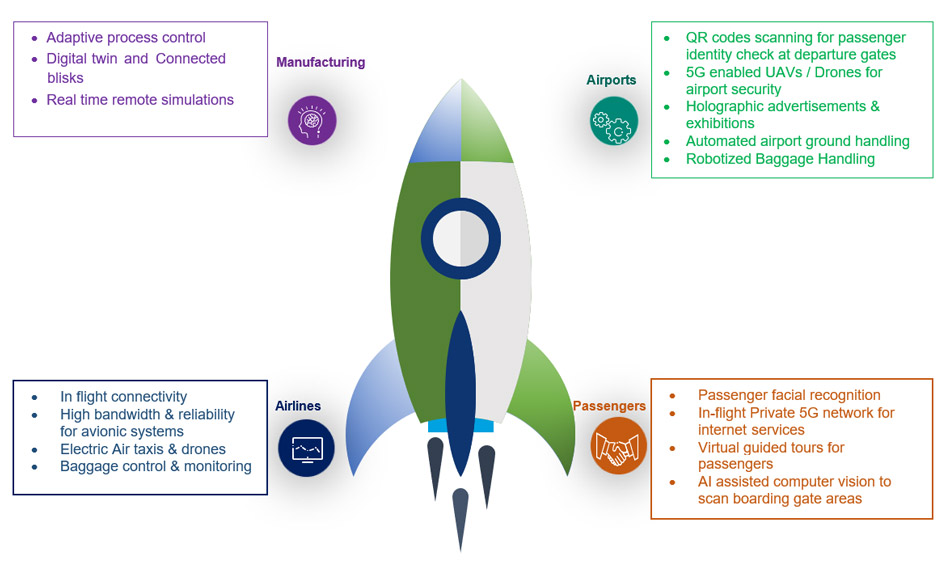While most media tout the impact of 5G on consumers, it’s the enterprise world where the technology will really take flight. Yes, 5G will enable video streaming at a high rate, and it will drive consumer services that currently reside in the realm of science fiction. But 5G’s underlying capabilities – Enhanced Mobile Broadband (eMBB), Massive Machine Type Communication (mMTC), and ultra-reliable low latency communication (uRLLC) – are ideal for business-critical applications.
5G is an ecosystem play where multiple technologies (e.g. EDGE and SD-WAN) complement and converge. With its vast capabilities, 5G could enable industrial IoT functions, for instance, to finally realize their potential. But where specific industries are concerned, few have the same 5G transformative potential as the aviation industry, which is projected to invest $3.9 billion in 5G by 2026 – growing at a CAGR of 52.7% from 2021. This projection is entirely justified; 5G will take the entire industry to new heights, from airports and airlines to manufacturers and passengers.
5G’s Impact on the Entire Aviation Lifecycle
If leveraged properly, 5G deployments will touch every facet of the aviation lifecycle. At a high level, 5G will transform the industry in four primary areas: manufacturing, airports, airlines, and the passenger experience.

Manufacturing
Before manufacturing even begins, real-time remote simulations are critical for multiple calculations and processing parameters. For example, IoT sensors collect simulation data for aircraft blades, which is then fed back to the machine control to derive crucial insights. 5G inherently accelerates this transmission, enabling manufacturers to perform advanced analytics and simulations sooner to identify and correct faults.
Similarly, 5G can provide manufacturers greater understanding of all its manufacturing processes/scenarios by enabling digital twins for aircraft blisks. Blisks are complex products that require high transmission rates, high reliability, and high data rates to produce. By deploying a 5G network on the production floor, manufacturers can ensure highly precise blisk manufacturing and real-time tracking capabilities as the blisk moves across the production line.
Airports
Two common areas of operational concern are security and weather-related tasks. One way 5G can improve airport security is by enabling network-connected 8K cameras and augmented-reality glasses. Thinking about security differently, 5G could also enable Automated Guided Vehicles (AGVs) to perform full disinfection based on real space occupancy, or allow airports to perform automatic fever detection via real-time thermal imaging.
Weather issues, meanwhile, can cause significant operational expense in addition to flight delays. With a 5G network providing high-speed connectivity, airports can monitor runways from the control tower and send autonomous snowploughs to clear the runways, reducing the reliance on on-call drivers.
Even the sharing of flight information, seat allocations and terminal data can be improved by 5G, whether through holographic advertisements or other bandwidth-intensive means to divulge dynamic, personalized information in real time.
Airlines
It’s easy to imagine 5G’s impact on a structure such as an airport, but the airlines themselves can leverage 5G technology as well. The avionic systems inside airlines, for instance, can have accelerated communication with control towers upon landing via highly reliable 5G connectivity. Also, real-time equipment monitoring using 5G networks can enable predictive maintenance, with 4K/8K video analytics enabling airlines to monitor aircraft turnaround processes.
Airlines could also improve their cargo and people movement, with 5G providing the backbone to deploy vertical take-off drones (e.g. electric air taxis) to the nearest location using a smartphone application.
Passenger Experience
The opportunities are vast to utilize 5G to provide an improved passenger experience. From a logistics standpoint, QR code scanning to verify passengers’ identity can considerably reduce waiting periods and long queues. Facial recognition using 5G-powered glasses and cameras could flag suspicious passengers and/or allow customs authorities to inspect passengers who are crossing borders. Real-time video streaming enabled through 5G could improve baggage control and monitoring, providing passengers with constant monitoring of their baggage during loading/unloading and the flight itself. And 5G-enabled computer vision could enable personalized services such as instantaneous scanning of boarding passes with minimal waiting periods and no manual intervention.
When on the airplane, passengers could benefit from a 5G-enabled experience by utilizing AR/VR capabilities to access 8K or UHD content, or by tapping into lighter-weight and faster in-flight entertainment services. And, much like they’d enjoy 5G connectivity on the ground, passengers would surely appreciate an in-flight private 5G network for Internet services rather than unreliable (and more-expensive) satellite communication links.
Conclusion
The sky is truly the limit when it comes to 5G’s ability to transform the aviation industry. Whether considering manufacturing, operations, or the passenger experience, 5G is poised to take the industry to new heights. With decades of experience in the industry, Wipro looks forward to designing, building and maintaining 5G-fueled innovations with aviation leaders.
Industry :

Aayush Kulshrestha
Solution Consultant, Enterprise 5G
Aayush holds experience in telecom domain and has worked with a leading global manufacturer of telecom and broadband equipment for mobile operators. His current responsibilities involve advisory and consulting on private 5G networks for energy and utilities, oil and gas, mines, travel, hospitality, and the public sector.

Ayisha Patnaik
Solution Consultant, Enterprise 5G
Ayisha is a part of the 5G Industry solutions team. During her first stint with Wipro, she closely worked around partnerships with telecom operators and was responsible for enterprise content management. Her primary responsibilities in the second stint include advisory and consulting on 5G and IoT portfolio for CPG, Smart City / Communities, Banking & Finance sectors globally.